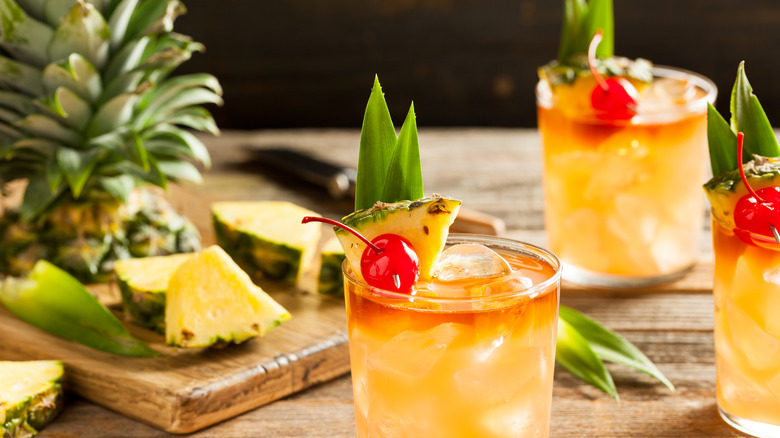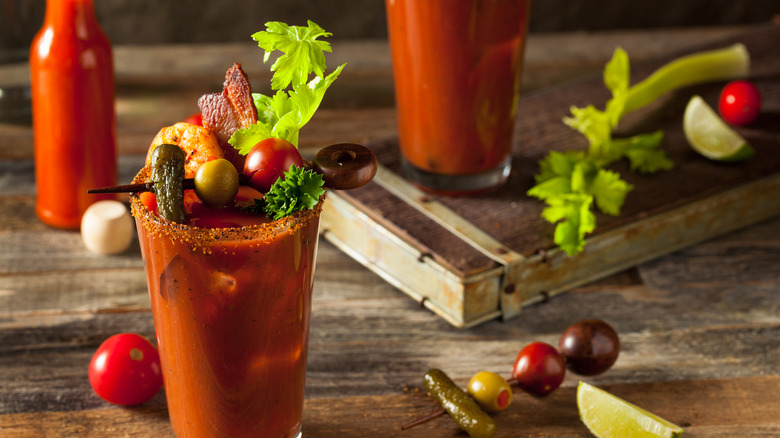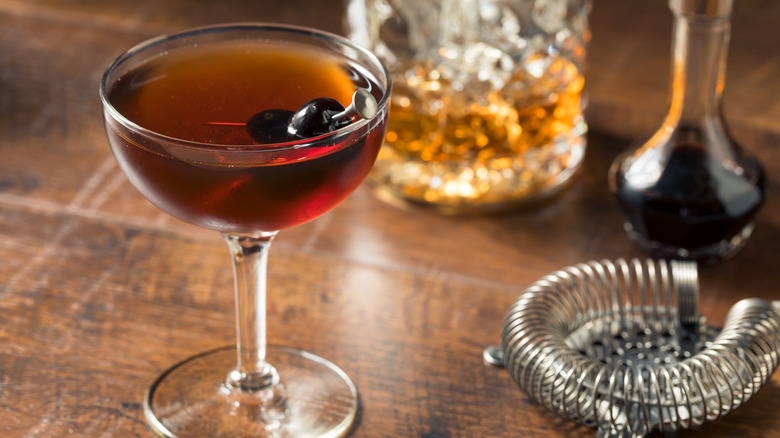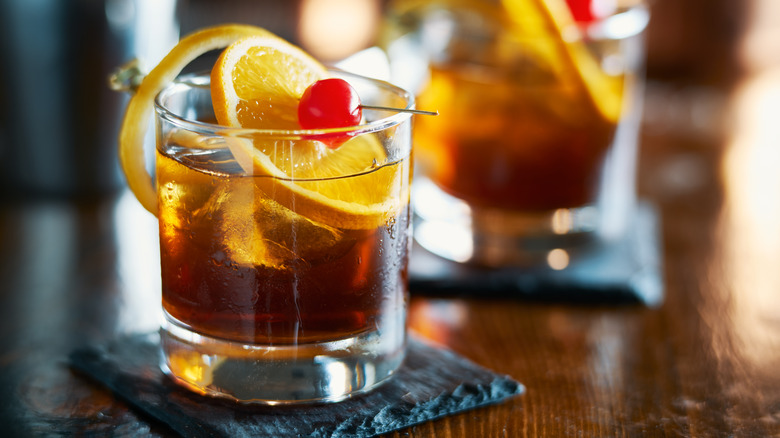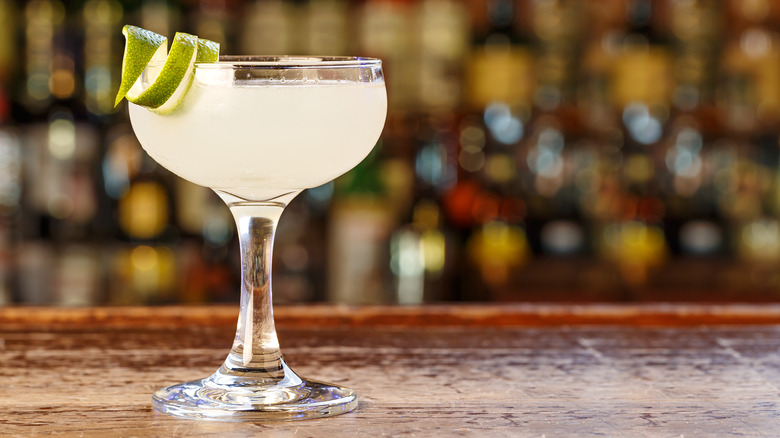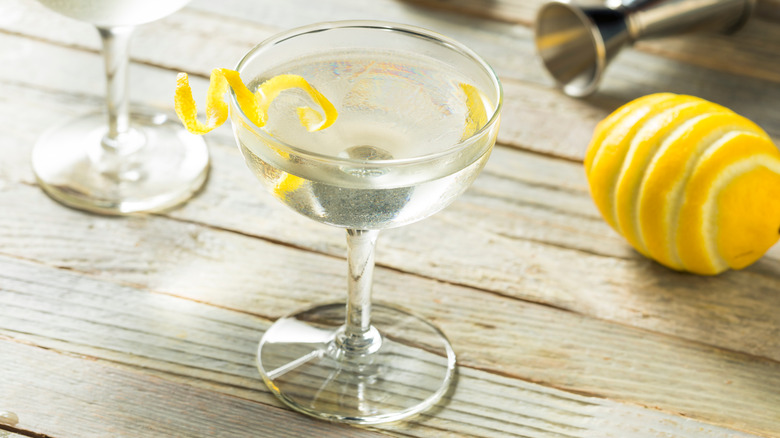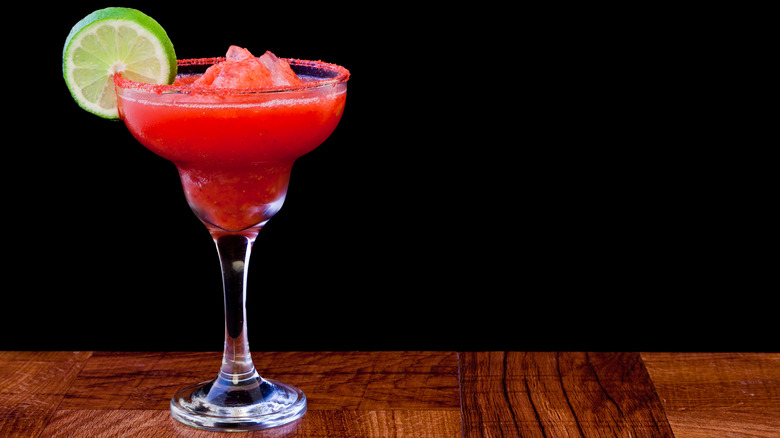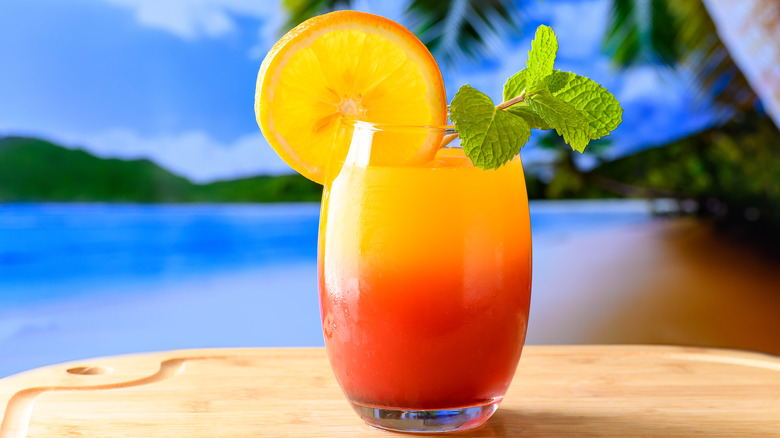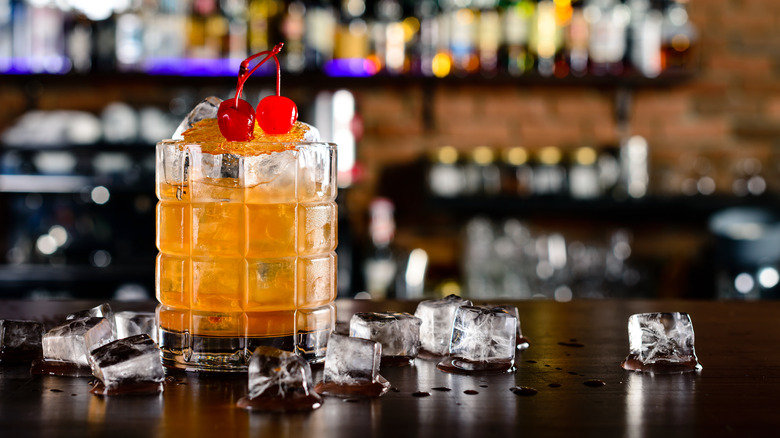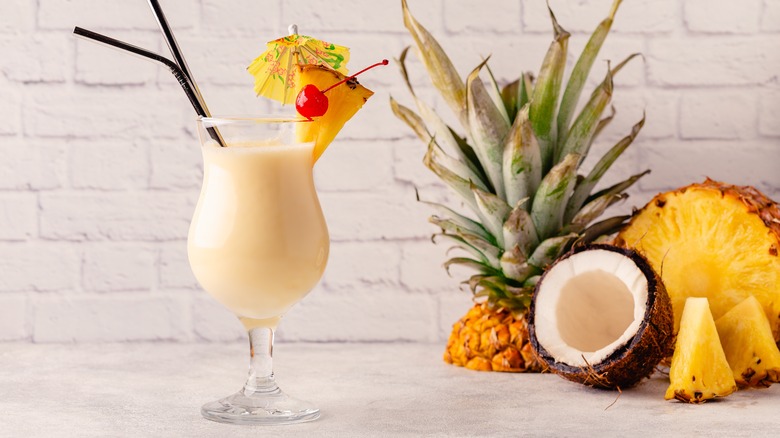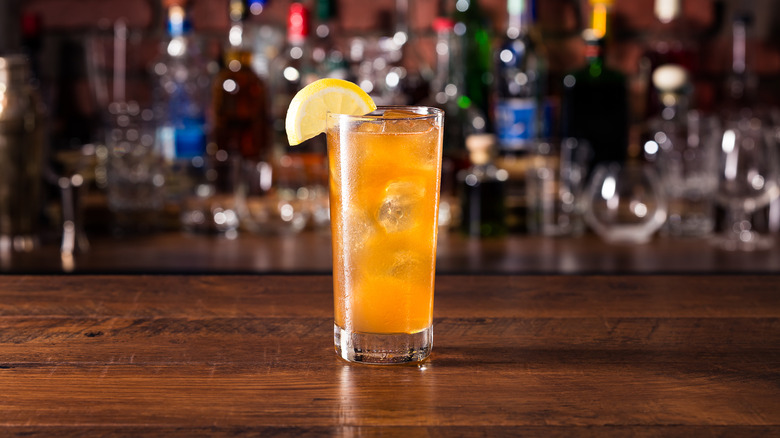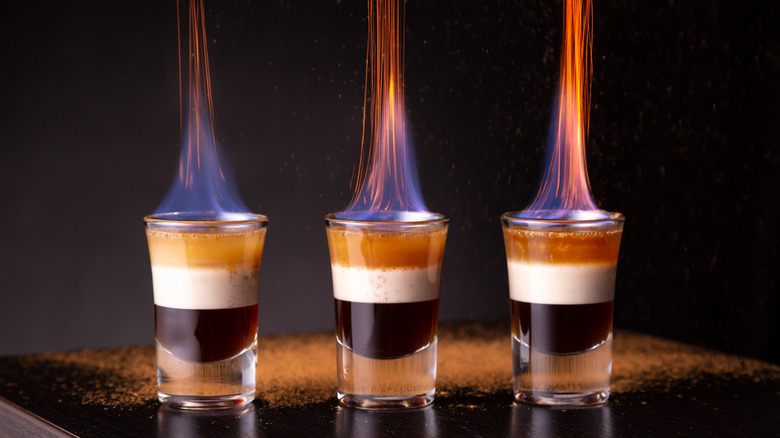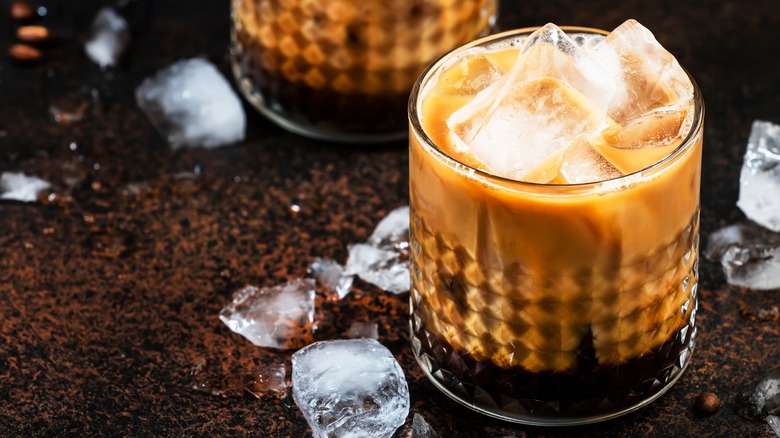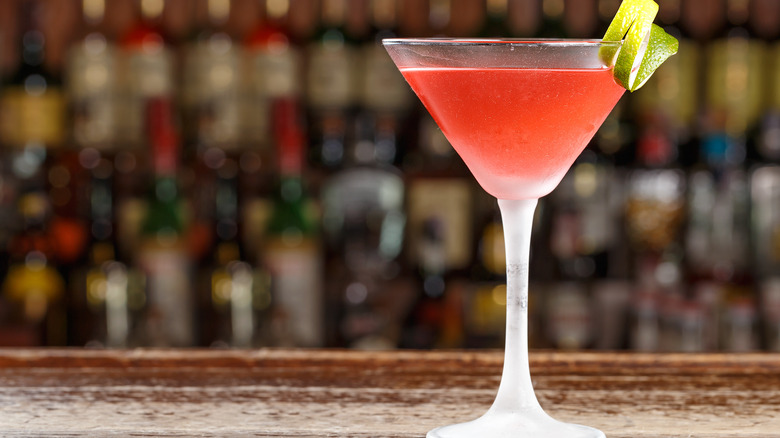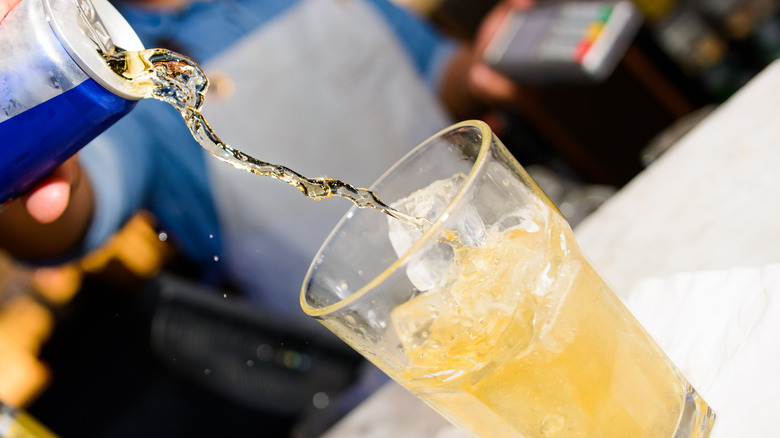The Most Popular Cocktail The Year You Were Born
We may receive a commission on purchases made from links.
Several different occasions call for serving cocktails. There are all sorts of reasons to raise a glass with loved ones and think fondly of a particular year. If you're seeking inspiration for a cocktail to serve for a birthday celebration, then you might want to consider popular cocktails according to the year in which you were born.
The exact origins of many cocktail recipes are murky and disputed, though, and it's also quite easy to switch up the ingredients to suit your personal taste, which many bartenders and home mixologists have done over the years. That makes it a bit of a challenge to discern exactly where and when the beverages both arrived on the scene and achieved peak popularity.
So, we looked towards a few historical facts and some pop culture references for some guidance on which drink was trending during a specific year or time period. If a drink is showing up on television screens or a major public figure is claiming to be a fan, we'd call that a landmark achievement for that particular cocktail.
Mai tai: 1953
While tiki culture had been in vogue for more than a few decades, by the time 1953 rolled around, it was really on the upswing. After World War II, veterans were ready to knock back a few adult beverages. Tiki drinks were a way for the veterans who spent time in the Pacific to reminisce on some of the few memories of the time that they spent there.
Trader Vic (also known as Victor Bergeron) originally prepared this cocktail for friends from Tahiti who visited his restaurant in Oakland back in 1944. But, we're noting 1953 as a specific year that the mai tai cocktail went mainstream because he was visiting Hawaii that year, and he convinced several hotels and cruise ships to start slinging his drink. Word spread that the cocktail was rather tasty, and it's still popular today. Fruit juice, rum, and curaçao are several key components, but orgeat is the most necessary ingredient. Orgeat is an almond milk syrup that adds an extra sweet punch.
Bloody Mary: 1955
The Bloody Mary, which is a combination of vodka, tomato juice, and Worcestershire sauce, is perhaps an acquired taste. The assortment of garnishes might be polarizing as well: Briny olives, a cornichon, a lime wedge, and celery stalks tend to be in the mix. While there's a lot of speculation over who came up with the Bloody Mary recipe, there's not much debate regarding when exactly it was extremely in vogue. Ordering a Bloody Mary was all the rage in the 1950s, and that's why 1955 was the height of its popularity.
Today, you'll find some 21st-century riffs on this mid-century classic. There are some over-the-top photogenic garnishes that are topped with cheeseburgers. Also, you can switch up things by using tequila instead of vodka in your Bloody Mary. Beer-based micheladas are on the same flavor wavelength and tend to have a lower alcohol content. But whichever path you take, the basic notion of a Bloody Mary is that it's a hair-of-the-dog hangover cure that's also conveniently packed with vitamins and minerals, so we wouldn't advise against ordering one from the brunch menu.
Manhattan: 1959
The Manhattan wasn't a new concoction when "Some Like It Hot" was released in 1959, but an iconic scene gave the cocktail even more popularity. The film's plot was set during the Prohibition Era, and it features Marilyn Monroe cobbling together makeshift Manhattans in the sleeper car of a train when she's thirsty for some late-night libations.
There might be myriad ways to make a Manhattan based on your particular liking, but the recipe for a classic Manhattan comes down to a small number of ingredients. The base liquor is generally whisky: We prefer rye, but bourbon is suitable, too. Then there's sweet vermouth: We like adding a splash of dry vermouth to make the ideal Manhattan. And, of course, you're going to want a dash or two of bitters along with a garnish of either maraschino cherry or a twist of lemon. For utensils, all you'll need is a shot glass and a cocktail shaker. When it comes to glassware, we recommend using stemless martini glasses and storing them in the freezer ahead of mixing and pouring.
Old fashioned: 1960
The old fashioned cocktail is reminiscent of the 1960s: The first season of the popular "Man Men" series was set in the 1960s, and it was known for its scrupulous dedication to accurately recreating the series' mid-century setting. And the central character, Don Draper, happened to be a big fan of ordering an old fashioned whenever he ambled up to the bar.
While the advertising genius always needed his secretary to have a stash of bottles of Canadian Club for his office, any whiskey (whether it's rye or bourbon) can function as the base for an old fashioned. Beyond that, mix together a light amount of bitters, sugar, and water and stir it up in a cocktail shaker. The Old fashioned is typically served in a lowball glass over a sizable cube or two of ice, along with a generous garnish of orange and perhaps a bright red maraschino cherry.
Daiquiri: 1963
While John F. Kennedy was very enthusiastic about the Bloody Mary cocktail, he was also reportedly a big fan of daiquiris. Unfortunately, 1963 would mark the last year JFK could delight in a daiquiri, making 1963 the year of the daiquiri. Whether you serve a daiquiri in an elegant coupe or on the rocks in a lowball glass, there's not very much that goes into a proper daiquiri beyond a bit of elbow grease. Lime juice is a key component, and so is simple syrup.
We like making our own simple syrup: All it takes is a one-to-one ratio of water and granulated sugar. Heat it up on the stove until the sugar is fully dissolved. You can further elevate your daiquiris by adding peels from the limes to the heated mixture so that the oils are infused into the syrup. Juice the limes to add to the cocktail, and don't forget to save a couple of twists, wheels, or wedges for garnish. The last step is to let the syrup cool and, most importantly, add a shot or two of rum to that cocktail shaker before the pour.
Vesper martini: 1964
Martinis had a game-changing moment in 1964 when the iconic phrase "shaken, not stirred" was uttered by Sean Connery in "Goldfinger." And because of those three words, we would argue that this was the year for martinis. Ian Fleming never made the preferred cocktail of his famous character James Bond classified information. Bond was canonically quite partial to a certain approach to a martini throughout the books and the films.
And due to the Vesper Lynd character in one of the earlier "Casino Royale" works, a particular cocktail recipe caught the attention of fans and was anointed the Vesper martini. To make a Vesper martini, start off with a blend of three parts herbaceous gin and one part clean, smooth vodka, both preferably top shelf if you're serving it to special agent 007. A light dose of the French apéritif Lillet Blanc should go into the shaker as well. To make an extra chic martini, add a citrus twist as the lemon garnish.
Frozen margarita: 1971
1971 is the year that brought some welcome relief to weary bartenders. Mariano Martinez, an overwhelmed restaurateur in Dallas, Texas, was besieged by thirsty customers repeatedly ordering his amazing frozen margaritas. He came to the conclusion that just having a few blenders would not be enough to keep up with the high demand. Martinez conceived the frozen margarita machine while grabbing a cup of coffee from his local 7-11 and spotting the Slurpee machine. After some attempts, he successfully married that technology with boozy beverages and thus birthed the frozen margarita machine. It was a light bulb moment in cocktail culture and kitchen science, and the results of his ingenuity are now at the Smithsonian.
Margaritas have long been a popular drink with their punchy duo of tequila and lime juice. Various other fruits like strawberries, mangoes, or pineapples also occasionally battle for center stage. However, if you're making frozen margaritas at home, don't buy a machine. You can stick to using a traditional blender. Make sure you always ask your guests if they'd like the rim of the glass salted or not.
Tequila sunrise: 1972
In 1972, the British-born Rolling Stones crossed the Atlantic yet again, and this time, they fell in love with the drink that has roots in Mexico. This cocktail is available in colors everywhere, and you might even say that it's like a rainbow. It all started after a bartender offered his version of a Tequila sunrise to the famous band in San Francisco, California, during their infamous "Stones Touring Party" tour.
The band was properly sauced from several rounds of the drink. They loved the Tequila Sunrise mixtures that they then adjusted their rider contract to ensure it would always be available to them for the remainder of the journey. There aren't many ingredients in a Tequila Sunrise: Just tequila, citrus juice, and grenadine. If you have crème de cassis, that's even better. But it's the grenadine that creates that gorgeous sunset visual. And after the first sip, it will really have your tongue wagging.
Harvey Wallbanger: 1977
In 1977, the infamous nightclub Studio 54 opened its doors, and it didn't take very long for the party to arrive. For many who bellied up to the bar before a few spins under the disco ball, the go-to order was a Harvey Wallbanger. The Harvey Wallbanger was one of the more popular cocktails of the 1970s, and the origin of its name may or may not be based on a true story. However, the ingredients that go into the popular drink are clear and rather easy to execute. This drink is essentially an elevated screwdriver: The basic ingredients entail a shot of vodka and a sweet pour of orange juice.
Galliano Authentico liqueur is the key ingredient in this cocktail that makes it so appealing. And it's worth having a bottle of Galliano around for appearances alone because of its high quality. This cocktail requires only an ounce or two of Galliano Authentico liqueur, and it adds a touch of color and a complex mix of herbal, minty, and spicy influences.
Piña colada: 1979
1979 is the year of the piña colada, and we would like to raise a toast to Rupert Holmes: His single "Escape (The Piña Colada Song)" soared to the top of the charts and gave a major shout-out to this chilly cocktail. The liquor base for this Caribbean-inspired drink recipe is rum, and we would opt for white rum over dark rum in this particular case. Beyond the booze, other key ingredients in this cocktail are pineapple juice and coconut milk. Another major component of this drink is ice because this drink was intended to beat the heat.
We're advocates for going in a frozen route, but it does take a bit of effort. If you're looking to make a frozen piña colada, you'll need to use a multi-purpose blender to get your mixture down to a fine texture. It's important to have a slew of hurricane glasses on hand to serve these up to your thirsty friends and family, and most importantly, don't forget to garnish the drink with a pineapple wedge.
Long Island iced tea: 1988
A movie by the name of "Cocktail" debuted in 1988. The film stars Tom Cruise, and it introduces audiences to the experience of working as a bartender. It displays all of the potential showmanship that can earn hard workers a few extra bucks in the tip jar. 1988 was also the year when the Long Island iced tea drink was really hitting its stride. And because the recipe has so many components, it felt even more appropriate to associate this beverage with the release year of that particular movie.
It's up for debate whether this intoxicating mixture first emerged in Long Island, New York, or Kingsport, Tennessee. At face value, the recipe for a Long Island iced tea makes zero sense. It's a confounding smattering of liquor: Gin, whiskey, rum, vodka, and tequila. You could get a hangover just by reading those ingredients. In addition to the liquors, this drink is then tempered by a nice dose of citrus juice (lemon or lime or a combination of both) and cola. It's typically served in a highball glass, and it miraculously does go down very easily: Whether that's a virtue or a cautionary tale is up to you.
B-52: 1989
The B-52 is a shooter drink that is truly on fire. We would argue that layered shots deserve a bit more attention, especially when they're done right. It takes a certain amount of skill and effort to make this portable beverage that's also a work of art. Some claim that the recipe behind the B-52 layered cocktail shot originated in the late 1970s at a hotel in Banff in Alberta, Canada, and that its name was inspired by a bartender who was a big fan of the band The B-52s.
While the group had been charting for around a decade, the B-52s had a major comeback year in 1989 with the release of "Love Shack" and "Roam," so that's why 1989 is the year of the drink by the same name. The basics of this particular layered shot start with a dose of coffee liqueur that's topped with Irish cream and finished with an orange liqueur such as Grand Marnier. Grab a lighter to light up this shot.
White Russian: 1998
Ordering a White Russian cocktail when you're out at the bar is a bit of a tell. You're likely a big fan of the 1998 cult classic The Big Lebowski. Adding syrup, fruit juice, or brine to an alcoholic beverage is the typical mixology move. But this film is set in the 1990s, and the main character, "The Dude," frequently imbibes White Russians.
White Russians prominently feature dairy. The cocktail's boozy base starts with vodka: This drink is quite neutral in flavor compared to other liquors, and it pairs well with a variety of different ingredients. Kahlúa (or any coffee liqueur) is key to this drink's recipe. We would advocate for whole milk when mixing this drink, but a small dose of heavy cream is even better. A Black Russian cocktail skips the milk altogether for those who avoid lactose. This is a great and tasty drink to order.
Cosmopolitan: 1999
While the quartet of gals on "Sex and the City" had gone out for a round of drinks in prior episodes, Carrie Bradshaw placed her first order for a cosmopolitan martini in season two, which aired in 1999. And just like that, the Cosmo became the toast of the town. We can understand why this cocktail would be a top choice for this cast of characters. It has a vibrant pink hue (courtesy of cranberry juice) that's accented by the contrast of a green lime garnish: It's sophisticated, vibrant, minimalist, and elegant in its appearance.
Why wouldn't it be a favorite drink of these notorious fashionistas? The main spirit in this cocktail is vodka, and it also gets a boost from Cointreau, but feel free to swap that out for another orange liqueur. After you get the lime garnish prepared, give the citrus a squeeze into the cocktail shaker and extract all of the juices. That acidity is key to balancing out the sweetness of the Cointreau and adding some pucker.
Vodka Red Bull: 2001
The Red Bull energy drink debuted in the United States in 1997. It has been a popular beverage in Austria since 1987. It took a few years for it to take hold as a non-alcoholic beverage and for its gathering base of fans to consider adding some booze to it. While you could add any liquor to Red Bull, vodka has been the victor.
It's hard to pinpoint the exact year the combination of vodka and Red Bull hit its stride, but from anecdotal experience, we would say it was sometime in the early 2000s, and others would agree. The appeal was not at all due to its flavor: The drink is ideal for a late-night bender, and thanks to the caffeine, it can give you an energetic boost. The popularity of this drink may have been due to the convenience of only two ingredients: It saves the bartender some sweat, and the thirsty customer gets their drink rather quickly.

